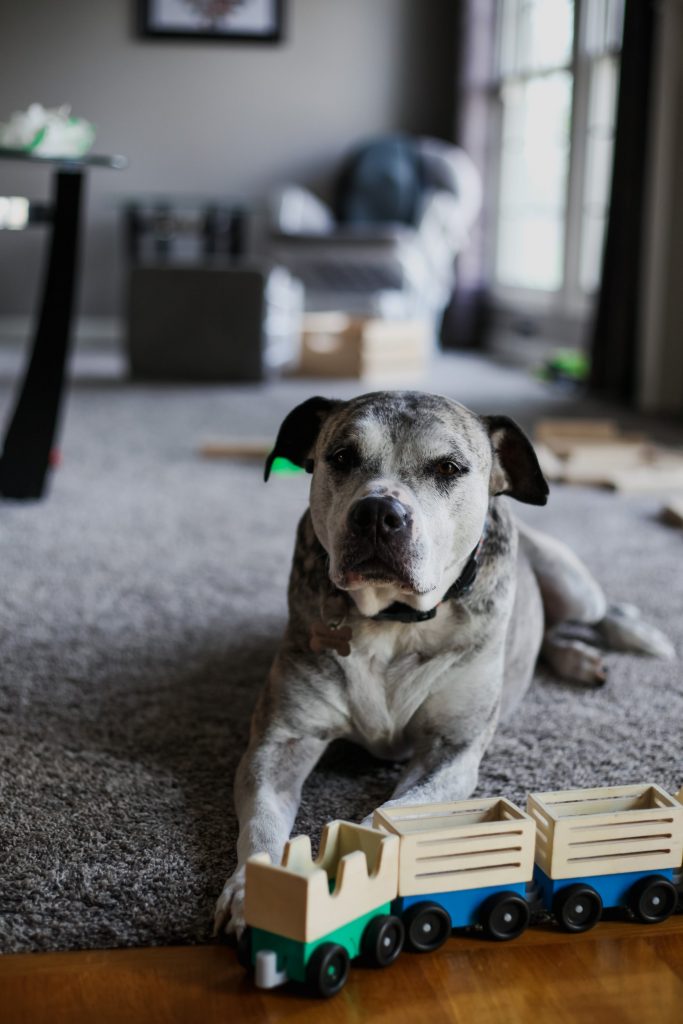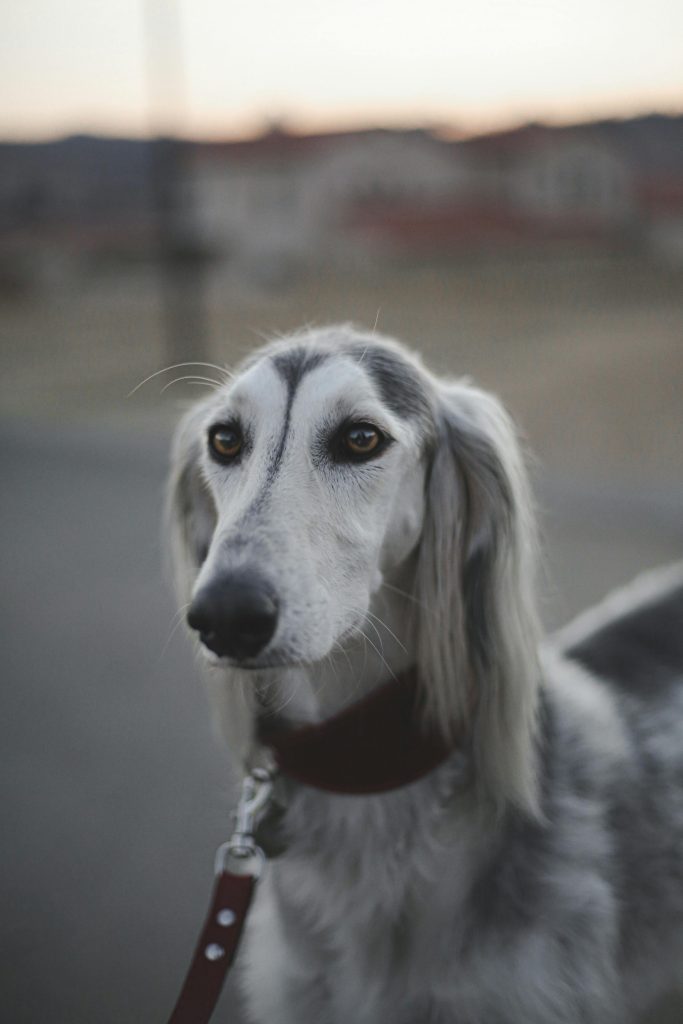Does your furry friend seem to be graying a little too early? This unusual phenomenon, known as premature graying, can startle any dog owner. From genetic factors to stress or health conditions, there’s a lot that could lead to this. Why is my dog going grey so early?
Join us in exploring the causes behind premature graying and what you can do to manage it for your pooch’s best wellbeing.

Key Takeaways
- Premature graying in dogs can occur due to factors such as genetics, stress, and medical issues.
- If your dog’s fur starts turning gray at a young age, it could be a sign of premature graying.
- To manage premature graying, reduce stress and anxiety in your dog’s life, maintain regular grooming, provide proper nutrition and supplements, and consult with a veterinarian for guidance.
Understanding Premature Graying in Dogs
Premature graying in dogs occurs when their hair begins to turn gray or white at a younger age than expected.
What is premature graying?
Premature graying is when your dog’s fur turns gray before it should. Usually, dogs start going gray between 7 to 10 years old. But sometimes, younger dogs also start having gray hair.
This is often due to stress or health problems like hypothyroidism. It can also happen if there are such genes in the family tree of the dog. Some breeds have a higher chance of getting gray early as well.
If you see your young pet turning grey, it’s good to ask a vet for advice.
Why does it occur?
Premature graying in dogs can occur due to a variety of reasons. One factor is genetics, as some dog breeds are more prone to early graying than others. Another factor is stress and anxiety, which can cause cellular stress and lead to premature gray hair.
Medical issues like hypothyroidism can also contribute to a dog’s gray hair appearing earlier than usual. It’s important to note that premature graying in dogs may be a sign of underlying health problems or behavioral issues, so it’s best to consult with a veterinarian if you notice your dog’s hair turning gray at an early age.
Factors that Contribute to Premature Graying
Premature graying in dogs can be influenced by genetic factors, stress and anxiety, as well as certain medical issues.
Genetic influence
Genetic influence plays a role in premature graying in dogs. Some dog breeds are more prone to early gray hair due to their genetic makeup. It means that if the parents or ancestors of your dog had gray hair at an early age, there is a higher chance that your dog will also experience premature graying.
Genetic factors can contribute to the loss of melanin, which is responsible for giving color to your dog’s fur. This loss results in the appearance of gray hairs before they naturally occur with aging.
If you notice your dog going gray early, it may be helpful to talk to a veterinarian about any underlying health issues and explore treatment options if necessary.
Stress and anxiety
Stress and anxiety can contribute to premature graying in dogs. Just like humans, dogs can experience stress and anxiety, which can affect their overall health, including their hair color.
Psychological distress in young dogs has been linked to the development of premature gray hairs. It’s important to address any sources of stress or anxiety in your dog’s life to help prevent premature graying.
Medical issues
Medical issues can play a role in premature graying in dogs. Health conditions like hypothyroidism, which is an underactive thyroid, can cause early gray hair in dogs. If your dog has sudden or excessive graying, it’s essential to consult with a veterinarian to rule out any underlying medical problems.
They can conduct tests and provide appropriate treatment if necessary. Remember that premature graying can sometimes be a symptom of a more significant health issue, so it’s important to address this with professional guidance.

The Difference Between Geriatric and Progressive Greying
Geriatric graying is a natural part of aging in dogs and typically occurs in older dogs, while progressive greying happens at a younger age due to genetic or health factors.
Signs to look out for
If you notice your dog’s hair turning gray at a young age, it could be a sign of premature graying. Keep an eye out for gray hairs on their face or muzzle, especially if they’re under 5 years old.
Premature graying can also be accompanied by behavioral issues like anxiety, impulsivity, and fearfulness. Other symptoms might include health issues such as hypothyroidism. If you see any of these signs, it’s important to consult with a veterinarian to determine the cause and appropriate treatment options.
Treatment options
If you notice your dog’s fur turning gray earlier than expected, there are treatment options available that can help manage premature graying. One important step is to reduce stress and anxiety in your dog’s life, as these factors can contribute to premature graying.
Regular grooming and maintenance can also help maintain the health of their coat. Providing proper nutrition and supplements can support their overall well-being and potentially slow down the graying process.
It is always recommended to consult with a veterinarian who can assess your dog’s condition, identify any underlying health issues, and suggest appropriate treatment options. Taking proactive steps to address premature graying in your dog can help improve their quality of life and keep them happy and healthy for as long as possible.

Tips for Managing Premature Graying in Dogs
Reduce stress and anxiety by providing a calm and stable environment for your dog.
Reduce stress and anxiety
Stress and anxiety can contribute to your dog’s premature graying. Studies have shown that psychological distress can lead to gray hairs appearing earlier in young dogs. It is important to create a calm and peaceful environment for your furry friend, as excessive stress can negatively affect their overall health and well-being.
Taking steps to reduce stress and anxiety, such as providing a comfortable living space, regular exercise, engaging activities, positive reinforcement training, and socialization with other dogs can help prevent or minimize premature graying.
If you notice signs of stress or anxiety in your dog, it is essential to seek professional guidance from a veterinarian or canine behaviorist who can provide appropriate recommendations for managing these issues effectively.
Regular grooming and maintenance
Regular grooming and maintenance are essential for managing premature graying in dogs. Proper grooming helps to keep the coat healthy, reduce shedding, and maintain a clean appearance.
Brushing your dog regularly not only removes loose hair but also stimulates blood flow to the skin, promoting a healthier coat. Additionally, regular bathing can help to remove dirt and debris that may contribute to premature graying.
It’s important to use products specifically designed for dogs to avoid irritating their skin.
In addition to grooming, maintaining proper nutrition is crucial for preventing premature graying in dogs. A balanced diet rich in essential nutrients can support healthy hair growth and delay the onset of gray hair.
You can consult with your veterinarian about dietary recommendations or consider adding supplements like omega-3 fatty acids or biotin to promote a healthy coat.
Lastly, it’s important to schedule regular check-ups with your veterinarian. They can assess your dog’s overall health and identify any underlying medical conditions that could be contributing to premature graying.
If necessary, they may recommend further tests or treatments.
Proper nutrition and supplements
Proper nutrition plays a vital role in maintaining your dog’s overall health, including their coat and skin. A well-balanced diet that is rich in essential nutrients can help prevent premature graying in dogs.
Make sure to feed them high-quality dog food that contains vitamins, minerals, and antioxidants. Supplements like omega-3 fatty acids and biotin can also promote healthy hair growth.
Consult with your veterinarian for specific dietary recommendations based on your dog’s breed, age, and any existing medical conditions they may have. Remember, a nutritious diet is key to keeping your pup looking vibrant and youthful!
Consultation with a veterinarian
If you notice your dog’s fur graying early, it’s important to consult with a veterinarian. They can help determine if there is an underlying health issue causing the premature graying.
Since gray hair in dogs can sometimes be linked to medical conditions like hypothyroidism, it’s crucial to get a professional opinion. A vet will be able to conduct tests and evaluations to rule out any potential health problems.
Remember, early detection and diagnosis are key for effective treatment and management of any underlying issues causing your dog’s premature graying. So don’t hesitate to reach out to a veterinarian for expert guidance and support.

Conclusion
In conclusion, premature graying in dogs can occur due to a variety of factors including genetics, stress, and medical issues. It’s important for dog owners to be aware of signs such as gray hair on the muzzle or behavioral changes.
By reducing stress levels, maintaining proper grooming, providing good nutrition, and seeking veterinary advice when necessary, we can help manage premature graying in our furry friends.
Remember to consult with a professional if you notice any concerning symptoms alongside the gray hair.
FAQs
1. Why is my dog getting gray hairs so early?
Early graying in dogs might be due to genetic factors, stress, or there may be health issues. Sometimes, getting older also brings on the grey.
2. Can stress cause premature aging in my dog?
Yes, high levels of stress can lead to behavioral issues and cause early graying in your dog’s fur.
3. Is it possible for mixed breed dogs to have prematurely gray hair too?
Absolutely! Premature muzzle graying can occur in all breeds of dogs including mixed breeds because of genetic dominance.
4. Does diet affect the color of my dog’s hair?
Yes! A poor diet lacking vital nutrients can result in melanin loss leading to premature graying in dogs’ hair.
5. Can health conditions trigger early graying?
Definitely! Hormonal imbalance and some underlying diseases could contribute towards premature aging causing gray hair even in young dogs.


